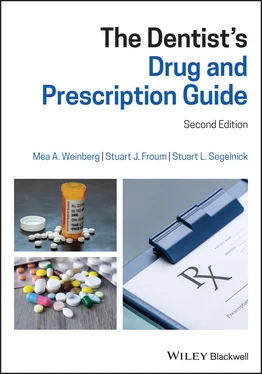4 Food and Drug Administration – Center for Drug Evaluation and Research (CDER) (2001). Statistical Approaches to Establishing Bioequivalence. www.fda.gov/downloads/Drugs/GuidanceComplianceRegulatoryInformation/Guidances/ucm070244.pdf.
5 Greene, W.L., Concato, J., and Feinstein, A.R. (2001). Claims of equivalence in medical research: are they supported by the evidence. Annals of Internal Medicine 132: 715–722.
6 Meridith, P. (2003). Bioequivalence and other unresolved issues in generic drug substitution. Clinical Therapeutics 25: 2875–2890.
7 Messerli, F.H. and Sichrovsky, T. (2005). Does the pro‐hypertensive effect of cyclooxygenase‐2 inhibitors account for the increased risk in cardiovascular disease? American Journal of Cardiology 96: 872.
8 Posner, J. and Griffin, J.P. (2011). Generic substitution. British Journal of Clinical Pharmacology 72 (5): 731–732.
9 Warner, T.D. and Mitchell, J.A. (2008). COX‐2 selectively alone does not define the cardiovascular risks associated with non‐steroidal anti‐inflammatory drugs. Lancet 371: 270–273.
10 Welage, L.S., Kirking, D.M., Ascione, F.J. et al. (2001). Understanding the scientific issues embedded in the generic drug approval process. Journal of the American Pharmaceutical Association 41: 856–867.
11 White, W.B. (2007). Cardiovascular effects of the cyclooxygenase inhibitors. Hypertension 49: 408–418.
www.deadiversion.usdoj.gov/pubs/manuals/pract/section5.htm
www.fda.gov/Drugs/DrugSafety/ucm239821.htm
www.blackboxrx.com
FDA Guidance for Industry. Dissolution Testing for Immediate Release Solid Oral Dosage Forms. US Department of Health and Human Services. www.fda.gov/regulatory‐information/search‐fda‐guidance‐documents/dissolution‐testing‐immediate‐release‐solid‐oral‐dosage‐forms
3 Basic Prescribing and Drug Dosing for the Dental Patient
3.1 Basic Principles of Drug Dosing
1 Q. What is the difference between dose and dosage form?
2 A. The dose of a drug is a specified quantity of a drug – the size or frequency at which the drug doses are administered. The dosage form of a drug is the drug formulation such as a tablet, capsule, syrup, liquid suspension, solution, ointment, or cream that generally contains the active drug substance in association with one or more inactive ingredients. The FDA has stated that a dosage form is the way of identifying the drug by its physical form, which is linked both to physical appearance of the drug product and to the way it is administered ( www.fdalawblog.net/fda_law_blog_hyman_phelps/2009/05/fda‐petition‐response‐reaffirms‐fda‐orange‐book‐dosage‐form‐nomenclature‐policy.html).If a patient is instructed to take one 500 mg capsule po (orally) qid (four times a day), the total dose is calculated from the dose multiplied by the number of times a day the dose is administered; one tablet (500 mg) qid is 2000 mg or 2 g.
3 Q. Why are some tablets “candy coated”?
4 A. These “candy‐coated” tablets are what is known as enteric coated. Some drugs are either irritating to the stomach lining or are inactivated, to different degrees, by acid in the stomach. To prevent the drug from being inactivated or destroyed in the stomach and allow it to travel to the intestine where it will ultimately be absorbed, enteric‐coated buffered tablets protect the drugs from gastric juices. Examples include erythromycin base, ibuprofen, and aspirin.
5 Q. Is it important to know the patient's baseline hepatic and renal function when deciding on the proper dosage?
6 A. Yes. Most drugs require adequate hepatic function for metabolism and adequate renal function for elimination. It is important to review the medical history and specifically ask the patient if they have any liver or kidney problems.
7 Q. What is the principle of selection of a therapeutic regimen?
8 A. Since the outcome of drug therapy is the product of a multifaceted interaction between drug and patient, the selection of an appropriate drug and dosing regimen is dependent on a thorough evaluation of the patient's medical and dental status and the actions and effects of the drugs to be used in treatment.
9 Q. What are the variabilities in drug dosage requirements?
10 A. There are many variabilities relating to alterations in drug dosing. The age of the patient, their renal and liver function, and pregnancy status can change the way the body reacts to medications.
11 Q. What are loading doses and maintenance doses of drugs?
12 A. Most drugs are not administered as a single dose. Rather, repeated doses resulting in an accumulation of the drug in the blood are needed to reach a plateau whereby the level of drug in the plasma is maintained constantly within the therapeutic range and there are no fluctuations in the concentration‐time profile. A steady state is achieved when the amount of drug absorbed into the body equals the amount of the drug leaving the body. To keep a proper steady state, the drug dosing must be consistent and the drug must be taken at the same time every day. Not achieving and maintaining steady state may make the drug therapy ineffective. It must be emphasized to the patient that the drug must be taken as prescribed. The drug should be taken at the same time every day and without any missed doses. In order to reach steady state, a loading dose is first administered on day 1, which is a higher amount of drug needed to quickly reach a therapeutic plasma drug concentration. Without a loading dose, it takes longer to reach steady state. After the loading dose is administered and before the plasma levels drop, a maintenance dose is given to maintain plasma drug levels within the therapeutic range. This maintenance dose is given in lower doses after the loading dose. For example, penicillin V is usually given as “1000 mg initially, followed by 500 mg every 6 hours.” Doxycycline is given as “100 mg every 12 hours on day 1, then 100 mg every day afterward.”
13 Q. How much loading dose is administered?
14 A. The loading dose is usually twice the regular dose.
15 Q. What drugs are given as an initial loading dose followed by a maintenance dose?
16 A. Antibiotics that are administered every 6–8 hours (including azithromycin, which is dosed once every 24 hours) usually require a loading dose in order to rapidly achieve a high tissue concentration for acute dental infections.
17 Q. How is a loading dose, followed by a maintenance dose, administered?
18 A. The loading dose is given on day 1, followed by the maintenance dose on day 1, day 2 etc….
19 Q. What is the proper duration of antibiotic treatment for dental infections?
20 A. Generally, the duration of antibiotic therapy has been variable and not evidence based. The current theory focuses on shortening the course of antibiotics, which might limit antibiotic resistance. Generally, most private practice and hospital‐based dentists empirically prescribe antibiotics for 7–10 days. However, high‐dose, short‐term therapy has also been advocated in medical guidelines. Prescribing antibiotics for three days has been shown to reduce the incidence of antibiotic resistance (Paterson et al. 2016). It is also important to take the antibiotic for the full course prescribed, even if the patient is clinically responding, in order to minimize the chance of the resistant bacteria not being targeted, thus preventing a relapse. However, there are no specific guidelines or recommendations regarding the duration of dental antibiotic therapy.
21 Q. What is the importance of knowing the peak concentration of a drug?
22 A. Peak concentration is the maximum plasma concentration of a drug which is seen during dosing intervals. At the time (usually hours) of peak concentration, the drug has the highest concentration in the plasma. Knowing the peak concentration of a drug is important because this is the time required if antibiotic prophylaxis is to be achieved. Antibiotic prophylaxis is defined as prevention of development of an infection at the surgical site (Munckoff 2005). For example, antibiotic prophylaxis is recommended by the American Heart Association (AHA) before a sinus graft is performed in anticipation of possible perforation of the Schneiderian membrane (creating signs and symptoms of sinusitis). Having the antibiotic already in the systemic circulation before the surgical procedure is performed is ideal for optimum therapeutic effects. Thus, before performing surgical procedures, the antibiotic needs to be administered only during the peak hours before the surgery and not days before.
Читать дальше












